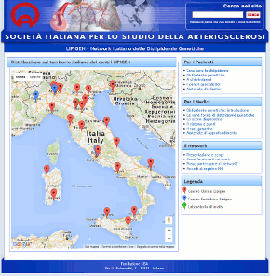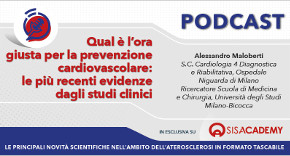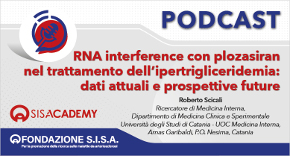 Rivista in lingua italiana
Rivista in lingua italiana
riservata ai Soci SISA
Ultimo numero:
Anno 16 • N.1/2025
SISANews
Atorvastatina e rosuvastatina hanno un effetto antitrombotico
Nell'ipercolesterolemia la biosintesi di trombossano A2 è aumentata per un meccanismo ancora non completamente chiarito, ma probabilmente legato alla perossidazione lipidica. In questo studio, atorvastatina e rosuvastatina hanno determinato una riduzione comparabile dell'attivazione piastrinica trombossano-dipendente e della perossidazione lipidica, in parallelo alla diminuzione del colesterolo LDL. I risultati depongono per uno stretto legame tra la biosintesi del trombossano A2 e la concentrazione del colesterolo LDL. L'effetto di inibizione delle statine sulla biosintesi del trombossano A2 non esclude comunque l'opportunità di una terapia con antiaggreganti piastrinici anche se l'obiettivo terapeutico per il colesterolo LDL è stato raggiunto.
![]()
Effects of atorvastatin and rosuvastatin on thromboxane-dependent platelet activation and oxidative stress in hypercholesterolemia
Puccetti L, Santilli F, Pasqui AL, Lattanzio S, Liani R, Ciani F, Ferrante E, Ciabattoni G, Scarpini F, Ghezzi A, Auteri A, Davì G.
Atherosclerosis 2011;214:122-128
OBJECTIVES: We examined the time-dependent effects of atorvastatin and rosuvastatin on in vivo oxidative stress and platelet activation, to assess whether these phenomena are related to any pleiotropic effect of any statin or to their LDL-lowering effect. We also asked whether the presence of specific allele frequencies in carriers of the 3'UTR/lectin-like oxidized LDL receptor-1 (LOX-1) polymorphism may influence the effect of either statin.
METHODS: We included 60 hypercholesterolemic subjects, previously screened for LOX-1 3'UTR polymorphism, randomized, according to genetic profile (15 T and 15 C carriers for each arm), to atorvastatin 20mg/day or rosuvastatin 10mg/day.
RESULTS: After 8 weeks, atorvastatin and rosuvastatin were associated with comparable, significant reductions in LDL cholesterol (40.8% and 43.6%, respectively), plasma hs-CRP (9.5% vs. 13.8%), urinary 11-dehydro-thromboxane (TX) B(2) (38.9% vs. 27.1%) and 8-iso-prostaglandin (PG) F(2a) (39.4% vs. 19.4%). The impact of rosuvastatin or atorvastatin on CRP, 8-iso-PGF(2a), and 11-dehydro-TXB(2) did not differ according to the LOX-1 haplotype. On multiple regression analyses, only CRP and LDL were independent predictors of 11-dehydro-TXB(2), and only LDL was a significant predictor of 8-iso-PGF(2a).
CONCLUSIONS: Both atorvastatin and rosuvastatin cause comparable reductions of thromboxane-dependent platelet activation, lipid peroxidation and inflammation. The presence of 3'UTR/LOX-1 polymorphism does not affect the changes induced by either statin.
Atherosclerosis 2011;214:122-128

Area Soci
Eventi
39° Congresso Nazionale
 39° Congresso Nazionale
39° Congresso NazionaleRoma, 23-25 novembre 2025
Save the date




 Spring Meeting Gruppi Giovani SID, SIGG, SIIA, SIMI, SIPREC, SISA
Spring Meeting Gruppi Giovani SID, SIGG, SIIA, SIMI, SIPREC, SISARimini, 6-8 aprile 2025
[continua a leggere]
 SISA LIPID ACADEMY - Corso avanzato di lipidologia clinica
SISA LIPID ACADEMY - Corso avanzato di lipidologia clinicaModena, 4-5 Luglio 2024
[continua a leggere]Giornale Italiano Arteriosclerosi
HoFH today
 Rivista Italiana della
Rivista Italiana della
Ipercolesterolemia
Familiare Omozigote
Anno 6 • N.1/2024
Rivista NMCD
Diateca
[continua a leggere]
[continua a leggere]
Newsletter
il vostro indirizzo di posta elettronica
Progetto LIPIGEN

Nuovo sito dedicato al Progetto LIPIGEN
Progetto LIPIGEN - Vecchio portale
E' necessario essere loggati come utente
Lipigen per poter accedere alla pagina
PROject Statin Intolerance SISA
PROSISA – PROject Statin Intolerance SISA
E' necessario essere loggati come utente
PROSISA per poter accedere alla pagina
GILA - Lipoprotein Aferesi
Gruppo Interdisciplinare Lipoprotein Aferesi
(Accesso Gruppo GILA-Lipoprotein Aferesi)
E' necessario essere loggati come utente del Gruppo GILA per poter accedere
Gruppo Interdisciplinare Lipoprotein Aferesi
(Documentazione ad accesso libero)
Pagina informativa per medici e pazienti










